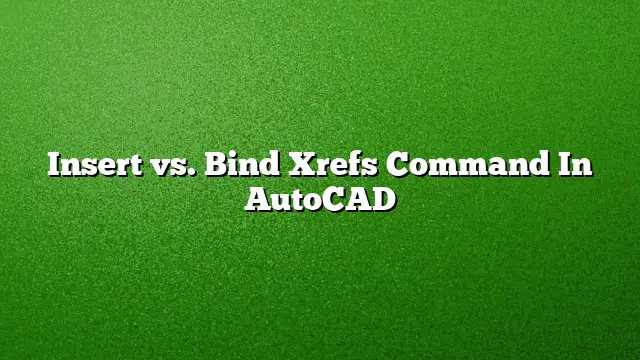Understanding the Differences Between Insert and Bind Xrefs in AutoCAD
When working with AutoCAD, users often need to incorporate external references, commonly known as xrefs, into their drawings. Two primary commands for this function are the Insert and Bind commands. While they may appear similar, each command has distinct characteristics and use cases that can significantly affect how your drawings are organized and managed.
Definitions of Insert and Bind Xrefs
-
Bind Xrefs: This command transforms the objects within the xref into a block reference. It also prefixes named object definitions with the original block name followed by a number (e.g., blockname$0, blockname$1). This helps in maintaining unique identifiers for objects, especially when dealing with duplicate names.
- Insert Xrefs: This command also converts xref objects into a block reference but merges named object definitions directly into the current drawing without any prefixes. It essentially integrates the layers and blocks into the drawing as if they were originally part of it.
Key Considerations When Choosing Between Insert and Bind
Selecting between the Insert and Bind options primarily hinges on how you wish to manage the layers and object definitions within your drawing. The Bind command preserves the integrity of the xref’s layers, while Insert merges them with existing definitions.
Step-by-Step: Binding an Xref in AutoCAD
-
Access the External References Manager: Open your current drawing and navigate to the External References palette (usually found under the "Insert" tab).
-
Select the Xref: Locate the xref that you want to bind.
-
Right-Click and Choose Bind: Right-click on the desired xref and select the “Bind” option. This action brings up a dialog box where you can choose between "Bind" and "Insert".
-
Select Bind: Click the “Bind” option. This will prompt you to choose how to manage the xref’s layers.
- Confirm and Complete: Once selected, the objects will be added to your current drawing with unique prefixes for layers. You’ll see new layers created based on the definitions in the xref, keeping their original properties intact.
Step-by-Step: Inserting an Xref in AutoCAD
-
Open External References Manager: Similar to the binding process, navigate to the External References palette from the "Insert" tab.
-
Locate and Select Your Xref: Find the xref that you wish to insert into your drawing.
-
Right-Click and Choose Insert: Right-click on the xref and select “Insert”. This option merges the xref objects into your current drawing without adding prefixes.
-
Choose Confirm Options: Ensure you verify any settings that prompt you related to layer management.
- Execute and Complete: The xref’s objects will now integrate directly into your drawing. Any objects or layers that already existed will be merged with their current properties, potentially altering their appearance based on the drawing’s configuration.
Benefits of Using Bind Xrefs
- Maintains Layer Integrity: Each layer retains its original properties and color, which helps in managing complex drawings.
- Prevents Name Conflicts: Unique prefixes eliminate confusion between similarly named layers or objects.
Advantages of Using Insert Xrefs
- Simplicity and Cleanliness: Creates a more streamlined drawing by reducing clutter, as no new layers are added.
- Immediate Visual Consistency: Existing objects and layers take on the properties of the current drawing, ensuring a uniform look.
FAQ Section
1. When should I prefer to use Bind over Insert?
Opt for Bind when you anticipate needing to keep the integrity of the xref’s layers and properties, especially in complex projects with multiple stakeholders.
2. Can I convert an xref from Insert to Bind later on?
No, once an xref is inserted with the Insert command, it cannot be converted to a binded version without redoing the integration.
3. What happens to existing layers when I use the Insert command?
When using the Insert command, existing layers with the same name as those in the xref will be merged, potentially altering their properties based on the current drawing settings.

